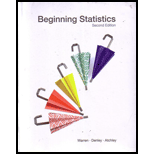
(a)
The
Answer to Problem 15E
Solution:
The expected value of Mike’s bet is
Explanation of Solution
Given Information:
Mike’s older brother, Jeff, bets him that he can’t roll two dice and get doubles three times in a row. If Mike does it, Jeff will give him $100.00. Otherwise, Mike has to give Jeff $5.00.
Formula Used:
The expected value for a discrete random variable X is equal to the mean of the probability distribution of X and is given by,
Where
Calculation:
There are 6 faces in a die. The total number of outcomes of rolling two dice is
The probability of rolling a double is
Each roll is independent of the others. So the probability of rolling two dice and getting doubles three times in a row is
Each roll is independent of the others. So the probability of rolling two dice and not getting doubles three times in a row is
| X | $100 | |
| 0.0046 | 0.9954 |
The expected value is given by
The expected value
Conclusion:
Thus the expected value of Mike’s bet is
(b)
The expected value of Jeff’s bet.
Answer to Problem 15E
Solution:
The expected value of Jeff’s bet is 4.517
Explanation of Solution
Given Information:
Mike’s older brother, Jeff, bets him that he can’t roll two dice and get doubles three times in a row. If Mike does it, Jeff will give him $100.00. Otherwise, Mike has to give Jeff $5.00.
Formula Used:
The expected value for a discrete random variable X is equal to the mean of the probability distribution of X and is given by
Where
Calculation:
There are 6 faces in a die. The total number of outcomes of rolling two dice is
The probability of rolling a double is
Each roll is independent of the others. So the probability of rolling two dice and getting doubles three times in a row is
Each roll is independent of the others. So the probability of rolling two dice and not getting doubles three times in a row is
| X | $5 | |
| 0.0046 | 0.9954 |
The expected value is given by
The expected value
Conclusion:
Thus the expected value of Jeff’s bet is 4.517.
(c)
The expected value of Mike’s bet.
Answer to Problem 15E
Solution:
If Mike and Jeff make the same bet 30 times, Mike is expected to lose $135.51
Explanation of Solution
Given:
Mike’s older brother, Jeff, bets him that he can’t roll two dice and get doubles three times in a row. If Mike does it, Jeff will give him $100.00. Otherwise, Mike has to give Jeff $5.00.
Formula Used:
The expected value for a discrete random variable X is equal to the mean of the probability distribution of X and is given by
Where
Calculation:
There are 6 faces in a die. The total number of outcomes of rolling two dice is
The probability of rolling a double is
Each roll is independent of the others. So the probability of rolling two dice and getting doubles three times in a row is
Each roll is independent of the others. So the probability of rolling two dice and not getting doubles three times in a row is
| X | $100 | |
| 0.0046 | 0.9954 |
The expected value is given by
The expected value
If Mike and Jeff make the same bet 30 times, then the expected value of Mike is
Conclusion:
Thus, if Mike and Jeff make the same bet 30 times, Mike is expected to lose $135.51.
Want to see more full solutions like this?
Chapter 5 Solutions
Beginning Statistics, 2nd Edition
 MATLAB: An Introduction with ApplicationsStatisticsISBN:9781119256830Author:Amos GilatPublisher:John Wiley & Sons Inc
MATLAB: An Introduction with ApplicationsStatisticsISBN:9781119256830Author:Amos GilatPublisher:John Wiley & Sons Inc Probability and Statistics for Engineering and th...StatisticsISBN:9781305251809Author:Jay L. DevorePublisher:Cengage Learning
Probability and Statistics for Engineering and th...StatisticsISBN:9781305251809Author:Jay L. DevorePublisher:Cengage Learning Statistics for The Behavioral Sciences (MindTap C...StatisticsISBN:9781305504912Author:Frederick J Gravetter, Larry B. WallnauPublisher:Cengage Learning
Statistics for The Behavioral Sciences (MindTap C...StatisticsISBN:9781305504912Author:Frederick J Gravetter, Larry B. WallnauPublisher:Cengage Learning Elementary Statistics: Picturing the World (7th E...StatisticsISBN:9780134683416Author:Ron Larson, Betsy FarberPublisher:PEARSON
Elementary Statistics: Picturing the World (7th E...StatisticsISBN:9780134683416Author:Ron Larson, Betsy FarberPublisher:PEARSON The Basic Practice of StatisticsStatisticsISBN:9781319042578Author:David S. Moore, William I. Notz, Michael A. FlignerPublisher:W. H. Freeman
The Basic Practice of StatisticsStatisticsISBN:9781319042578Author:David S. Moore, William I. Notz, Michael A. FlignerPublisher:W. H. Freeman Introduction to the Practice of StatisticsStatisticsISBN:9781319013387Author:David S. Moore, George P. McCabe, Bruce A. CraigPublisher:W. H. Freeman
Introduction to the Practice of StatisticsStatisticsISBN:9781319013387Author:David S. Moore, George P. McCabe, Bruce A. CraigPublisher:W. H. Freeman





